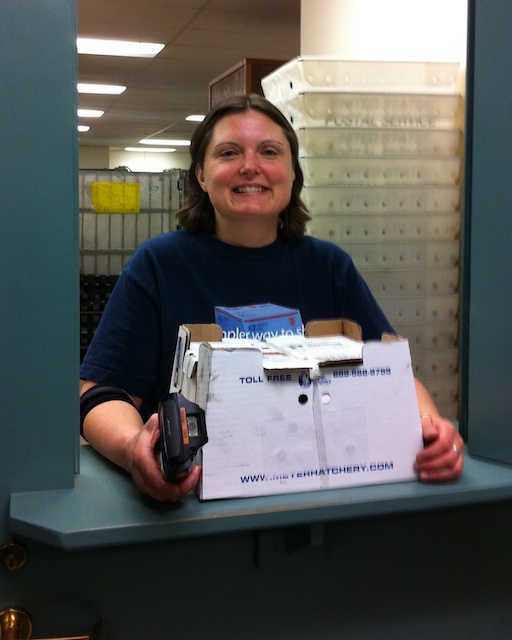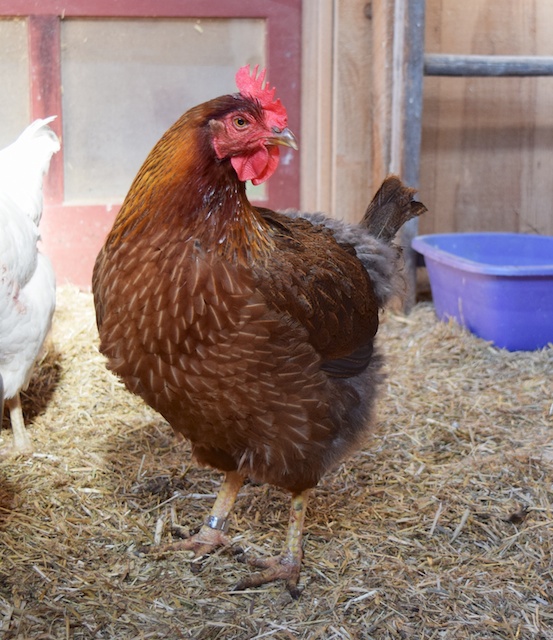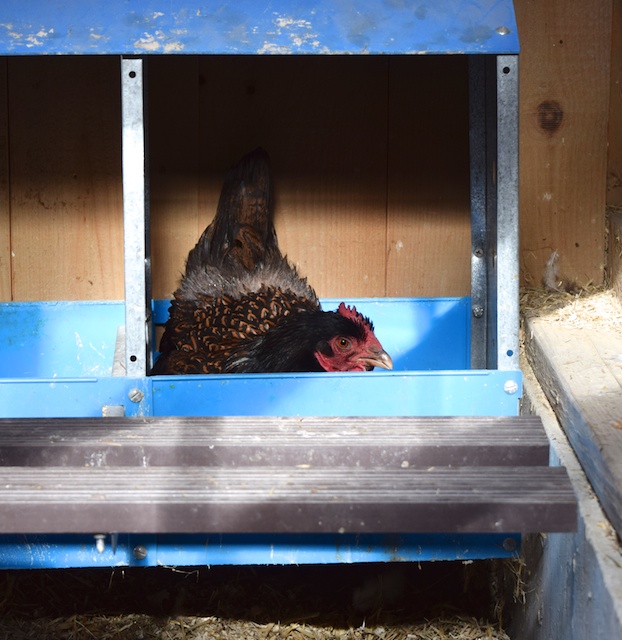I call the flock of hens that you see on the BarnCam the Gems, because they are named after rocks (Etheldred honors a pioneering female geologist.) They arrived in a cardboard box, through the mail, from Meyer Hatchery in April of 2011.
The fuzzy chick phase lasts but a short couple of weeks.
By late summer of 2011, the Gems were laying. They’ve now gone through two molts.
The Gems still look good.
Pearl is in all of her fluffy cochin glory.
Despite losing her tail to feather picking, and having a rough-looking rump, Jasper continues to be friendly, alert and active. (All of you with feather picking in your flock, take heart! Sometimes the hen just doesn’t care.)
Amber continues to be the perfect Buff Orpington. She has all of their good traits, but she never goes broody.
The Gems continue to lay eggs.
Despite their outward glossy and healthy appearance, the Gems are old.
It’s hard to accept that the normal-looking hens in your flock are old, but by the age of three they are. Don’t believe all of the backyard chicken boosterism that claims that you’ll have hens living and laying for a decade. A rare bird might, but most won’t. At three, laying hens are past their prime. It’s true that many of your hens will keep laying, albeit at a reduced rate. But, it’s not just that the hen is producing fewer eggs, it’s also that they have difficulty constructing sturdy shells and laying without issues. It takes a lot for a chicken to metabolize nutrients from feed and turn it into eggs. By their third laying season, their nutritional tracts aren’t up to the job. Sometimes, internal organs are tumorous. Sometimes, they’ve just not as efficient at digestion.
Early this springtime, there were days when I collected ten eggs from this group of eleven birds. But, lately, that number has halved. It’s not just the rate of laying that has slowed. Egg laying has become problematic for some of the girls. Egg shells are thinner. Some are so fragile that they break, and then the hens eat them. Once in awhile an egg is laid that is as soft as a water balloon. These sorts of glitches lead to bigger problems. The chickens strain to lay rubbery eggs. An egg might break inside of the hen. Eggs might back up in the tract and they become impacted, or the hen will become an internal layer. I’ve seen all of these problems, and I’ve confirmed them by doing necropsies after death.
If I was a “real” farmer, this flock would be gone. The shells would be too thin to pack in cartons without cracking. The margin for making a profit would disappear. But, I’m not a farmer. I have hens in my backyard that I’ve gotten to know. I can afford to keep them around. Because I know what’s going on with the Gems, I can do a few things to make egg laying easier for them.
An optimal diet for the older hen is essential. They need chicken grit – yes, you have to spend $10 on a bag of rocks. Without grit of the right size and type, they can’t grind food up in their gizzards. They need oyster shell, offered free choice. (I use a rabbit food dispenser.) Most importantly, they can no longer eat anything and turn around and make eggs. They can no longer be given all of your kitchen scraps. No more bread and pasta. No empty calories. Forgo the scratch corn, too. They should fill up on pellets before being given healthy treats such as greens and watermelon. However, finding goodies by free-ranging on your lawn and garden is still a good thing.
I’m now treating my healthy-looking Gems as the old girls that they are. Careful management will allow them to lay eggs as sturdy as they can make them. Some hens will sail through the next few years. I hope that most of them do. But, I expect that I’ll see difficulties in the months to come. This is as much a part of chicken keeping as is being smitten by those day-old chicks. This is not depressing. Being realistic about your animals’ lives allows you to enjoy them for who and what they are and to care for them appropriately. Meanwhile, it’s a beautiful day and I need to get into the garden. The hens are ready to help with the bug control and turf turning, and I look forward to their company.







WOW time flies.
Thank you for the advice about food for older hens. My three Buff Orps are 7 years old now and looking just as great as they did as pullets. This is the first spring when they have not laid one single egg. I am grateful for whatever good health they appear to have right now!
I know your gems will be fine.
Thoughtful, insightful and realistic as always. I wonder Terry, if there is a book on general hen health/raising hens that you might recommend above others. I’ve heard much praise for Storey’s Guide but would appreciate your thoughts. Thanks Terry.
The Storey’s Guide is by Gail Damerow and she’s excellent. She backs up what she says with research and has many years of experience. She is based in the south, so she doesn’t have first hand experience with your weather, though I think that she understands it.
just wondering as we have chick starter feed and layer feed would our OLD hens internal issues be less of problem if they were OFF layer feed as they get older an have egg issues.
Is there old hen feed?
There is no old hen feed. I’d keep feeding them the mature chicken ration, as their bodies still need calcium (which isn’t in the chick feed) and supplementing that with dark leafy greens, alfalfa if you have it, squash, etc. A little extra protein might help – but not in excess. If they’re free-ranging and getting bugs, that’s great! If not, a teaspoon of hulled sunflower seeds (per bird) is good.
A very interesting post, and very relevant to me at the moment. My hen is 3 1/2 years old now and she is laying soft/no shell eggs (she has been such a prolific layer). She feels poorly every so often and goes very quiet and withdrawn (I usually give her a dose of epsom salts) and then she perks up and is absolutely fine. She is still really enjoying life (living with her younger “sister”) but I do worry about these “off days”. I know, however, that it is just an age thing and I just have to look after her and give her the best life possible. Thank you for pointing out the fact that this is all part and parcel of keeping chickens (as pets). I lost my first 2 hens at about 18 months old, due to internal laying EYP. She is fed on layers pellets and has greens (access the free range when I am at home). I will, however, get a supply of grit. I also, on a vets recommendation, when my other 2 hens were poorly sprinkle a calcium supplement called Nutrobal in their food. I wish that she could stop laying altogether as I love her for her not the eggs! Again, a very informative post, thanks for the advice. Regards.
I’d like to say that
“Most importantly, they can no longer eat anything and turn around and make eggs. They can no longer be given all of your kitchen scraps. No more bread and pasta. No empty calories. Forgo the scratch corn, too. They should fill up on pellets before being given healthy treats such as greens and watermelon.”
this diet should be followed from the beginning, so the birds have the healthiest body to start with. That would give them a big leg up on longevity and health.
Also, I wonder if feeding non-GMO feeds would reduce the tumor loads? Or feeding low soy/no soy feeds also? I wonder if anyone has done a reliable study on this? Not many farmers will keep hens past production, so it might be hard to find out.
No studies have been done. In fact, there’s nothing out there about aging hens, as this is a new phenomena. However, there has been work on tumors – and at least in younger hens, many are attributed to the Marek’s virus.
Great post< I have 4 older girls 3 are 3y/o and 1 is 4y/o all are still Laying there is a slight decline and slightly thinner shells with my 2 Silver laced wynadottes, My silkie is laying they same as always and her shells and membranes are strong as ever, she is the 4 year old, though this is probably because of her long breaks of not laying with broodiness and molting, and my Jersey girl she is still laying 4 to 5 eggs a week at 3 years old her eggs are slightly thinner, but still sturdy, I just read that Jersey Giants lay the most eggs between 18 months and 4 years, this is due to the fact they take longer to Mature.